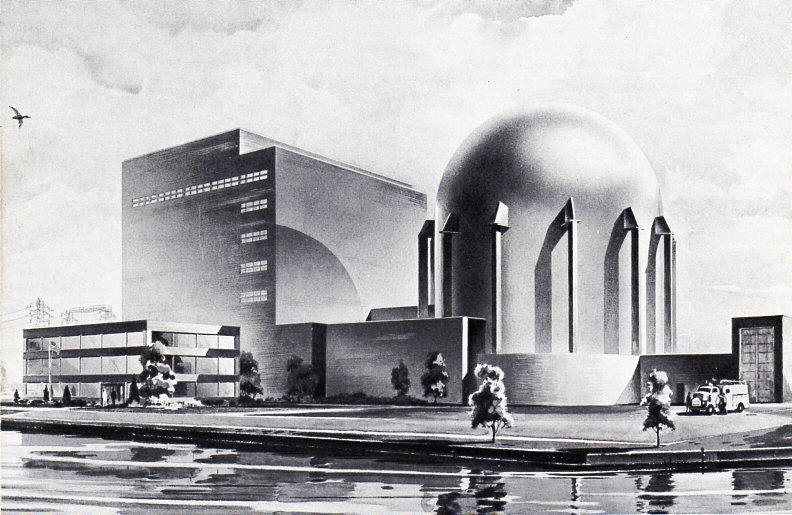Nuclear Power Reactor Technology, 1950-1953 (Part II)

1955 artist's concept of the Enrico Fermi Atomic Power Plant. (Will Davis collection)
In the previous installment, we looked at the first of four projects to study nuclear power plants in the 1950-1953 time frame, as part of a group of studies for the U.S. Atomic Energy Commission (AEC). This time we'll look at two more.
Dow Chemical Company and Detroit Edison Company
This study was far less detailed than the first, at least in terms of producing information about what an actual power plant would look like and what its parameters would be. Instead, Dow and Detroit Edison looked at broad requirements for what they felt would be an economical power reactor-and developed the following points:
"Specifications for Economical Nuclear Power"
1. The reactor should utilize low-cost fuel, i.e., it should be a breeder reactor that within itself converts thorium or depleted uranium to fissionable material for fuel. Throughout this discussion, breeder reactor is taken to mean a machine that produces more fissionable material than it burns, whether it is the same or a different material.
2. The reactor should have a high-breeding gain, e.g., be a fast-neutron reactor, to produce an excess of fissionable materials above its own fuel requirements.
3. The reactor should be a high-temperature machine if it is to produce power as well as fissionable materials. There appear to be possibilities of reaching the range of 500 to 600 °C (950 to 1100 °F) in the reactor core.
4. The reactor should be of such a design as to permit integration with a variation of extraction processes under study at the Ames Laboratory, Ames, Iowa, and the Brookhaven National Laboratory, Long Island, N.Y., permitting fast low-cost processing and recovery of fissionable materials and fission products.
5. The reactor should require a minimum exclusion area. Continuous removal and segregation of the fission products would reduce the size of the area required. The separations processes mentioned above indicate promise in this direction.
6. The reactor should use uncanned fuel, preferably mobile or fluid fuel.
7. The reactor should be inherently self-regulating.
These points were all combined into a general concept for a reactor that was not fully designed at this time. Importantly, while the companies stated that they wished to combine the largest number of positive points into their generic design concept as possible, it was also necessary to look at designs that could reasonably have been expected to show considerable promise in the next several years. Because the fluid fuel concept was by no means proven, the decision was made to select a metal-cooled, fast-breeder reactor with canned (discrete, or solid) fuel elements.
It should come as no surprise that this is exactly the path followed by Detroit Edison, and later by Atomic Power Development Associates and Power Reactor Development Corporation when these entities collaborated on the design and construction of the sodium-cooled, fast-breeder Enrico Fermi Atomic Power Plant (as shown at the top of this article). That reactor was ordered in 1957; Dow Chemical was not involved. This was the only one of the four studies that appears to have led to a long term successful effort, although the weapons production aspect was not included in the actual plant.
Monsanto Chemical Company-Union Electric Company
These companies considered that any reactor type included in the study had to actually be available in the near term, i.e., from four to six years from the study date in 1953, and assumed that the reactor would eventually be used for power production only, after plutonium requirements were met. (As we know from Part 1 of this series, all of these reactors were, at least initially, to have been power and weapons material producers.) The companies credited the "usual life" of a power plant as being 20 to 35 years.
The winning concept was for a sodium-cooled reactor using a graphite moderator and unenriched metallic uranium fuel elements. (This beat the following: sodium-cooled, heavy-water-moderated; light-water-cooled and moderated; aqueous homogeneous; and some "special types.") The study considered the need to switch the reactor from dual nature to just power production after five years of operation, and the consideration was actually made to allow replacement of the nuclear steam supply system by fossil-fired boilers when the time came to no longer sell plutonium to the AEC.
An interesting aspect of the design study was concerned with power control, or load following. It was reasoned that the high-steam flow (for that time) to the twin turbine generators (two 110,000 Kw units) would make load control by throttling impractical-and it was also reasoned that "since the production of plutonium is our prime criterion of operation, its production rate should be maintained regardless of electric demands or turbo generator availability." Thus, the plant was planned to have a 100 percent full-power steam dump, bypassing the turbines to the condensers so that the reactor could operate at full-rated power at all times regardless of system demand for electricity-even if it were zero.
Next time-our third and final installment shows some great illustrations of the last project.
----------------------------------------------------------------------------------------------------------
 Will Davis is Communications Director and board member for the N/S Savannah Association, Inc. He is a consultant to the Global America Business Institute, a contributing author for Fuel Cycle Week, and he writes his own popular blog Atomic Power Review. Davis is also a consultant and writer for the American Nuclear Society, and serves on the ANS Communications Committee. He is a former US Navy reactor operator, qualified on S8G and S5W plants.
Will Davis is Communications Director and board member for the N/S Savannah Association, Inc. He is a consultant to the Global America Business Institute, a contributing author for Fuel Cycle Week, and he writes his own popular blog Atomic Power Review. Davis is also a consultant and writer for the American Nuclear Society, and serves on the ANS Communications Committee. He is a former US Navy reactor operator, qualified on S8G and S5W plants.

